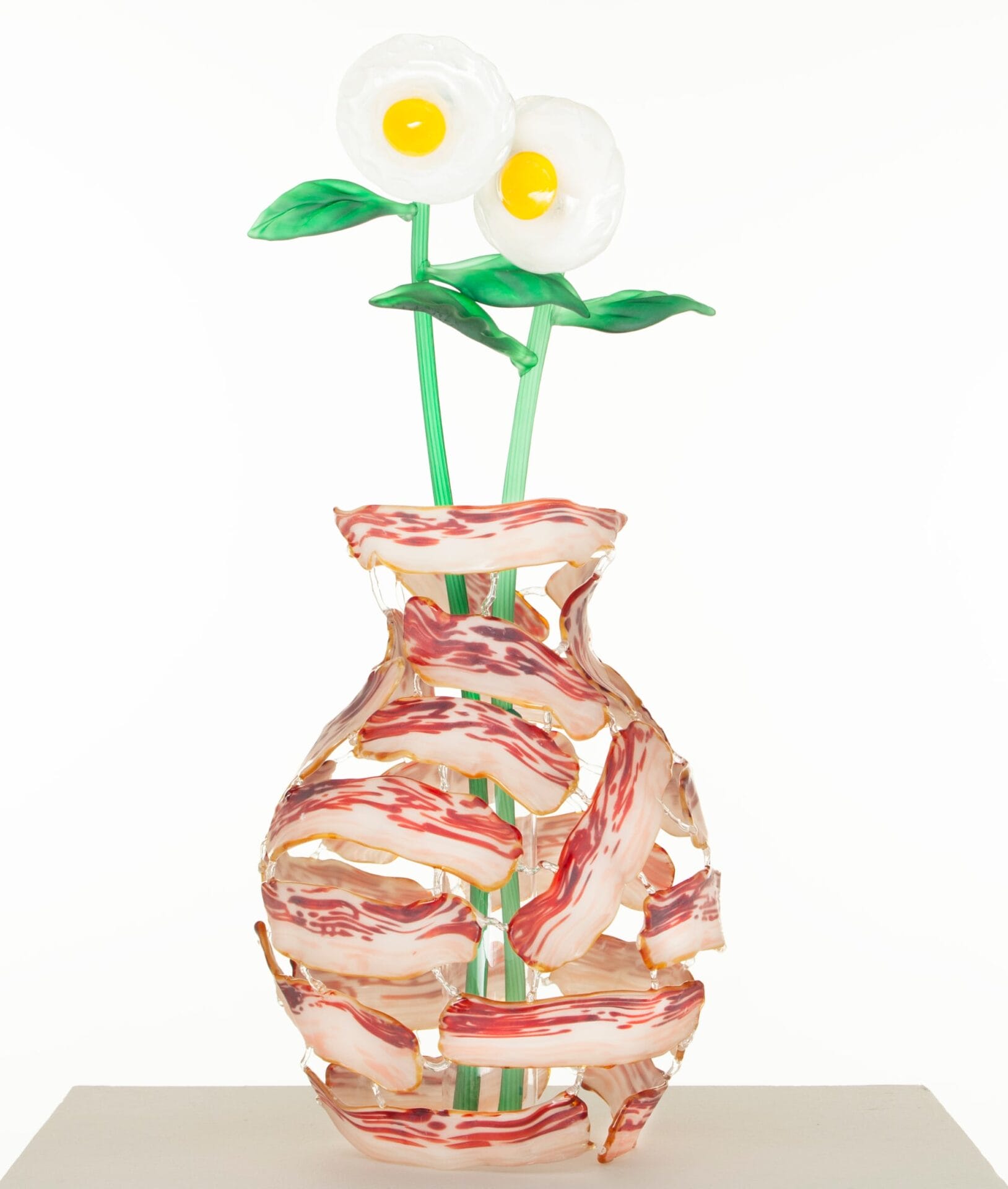Detail of “A Drexcyen chronocommons (To win the war you fought it sideways)” (2019), two paintings, hand-painted wooden frame, perforated tarp, printed mesh, handmade paper over found objects, plants, books, Oman incense, and palo santo, 373 1/4 × 447 1/8 × 157 1/8 inches. Photo by Phoebe d’Heurle. All images courtesy the artist and Hauser & Wirth, New York, © Firelei Báez, shared with permission
Abstraction, for Firelei Báez, is like a map legend, a system designed to help the viewer navigate the worlds she envisions. Her works, heavy with drips, splatters, and lively explosions of color, emerge from what she refers to as “the mirage,” the place where the colonial narratives that tangle fact and fiction begin to unravel.
Born and raised in the Dominican Republic before moving to New York as a young adult, Báez frequently returns to the histories, myths, and linguistic traditions of the Caribbean. Books, maps, blueprints, and other materials removed from libraries and museums are her preferred substrates because they offer an opportunity to reshape the dubious scientific methods and discriminatory systems they express. She invokes figures like Swedish biologist Carl Linnaeus, for example, who developed one of the first taxonomies and laid the foundation for what became widespread scientific racism.
“Untitled (Temple of Time)” (2020), oil and acrylic on archival printed canvas, 94 1/2 × 132 3/8 × 1 5/8 inches. Photo by Phoebe d’Heurle
In an in-depth interview with Louisianna Channel, Báez describes her preference for leaving the crinkles and folds of these materials visible. She prefers to keep her additions small so viewers get physically close to the works, where they can see evidence of wear and read the original content through her vivid plumes of color. “I’m fully capable of making a juicy, beautiful painting that is just all pleasure. And that’s good. But that only sustains for a short period of time,” she says. “I’m interested in giving something that is generous enough to make it linger in your mind afterwards.”
Often working with her canvas on the floor, the artist pours and splatters paint, allowing gravity to mix and meld the pigments into mottled colors. She likens herself to a filter through which an immense energy passes and flows into the pieces. This vigor emerges in works like “Untitled (Temple of Time),” which radiates a kaleidoscope across Emma Willard’s 19th-century lithograph that chronologically charts an imperialist history of the world.
“Drexcyen chronocommons (To win the war you fought it sideways)” (2019), installation view, James Cohan, New York, 2019. Photo by Phoebe d’Heurle
While aesthetically alluring, each bold color is loaded with historical and cultural context, and Báez has extensive knowledge of her palette: blue, for example, evokes Celtic warriors, the Virgin Mary, and the deities of the ocean. The artist’s immersive “Drexcyen chronocommons (To win the war you fought it sideways),” which drapes an undulating canopy across the gallery, swaths the space in cobalt, navy, and aquamarine. Magically illuminated, the work, like others in Báez’s oeuvre, references the myth of Drexciya that says that the unborn children of African women thrown overboard during the transatlantic slave trade now populate an underwater world.
When working figuratively as in “Can I Pass? Introducing the Paper Bag to the Fan Test for the Month of July,” Báez gravitates toward the inscrutable and unruly. She prefers not to render full faces because of racial coding and instead focuses on the sensual interactions between the subject and the viewer. “My ideal figure would evade all categorization,” she says. “The body is enough.”
Báez’s first museum survey opens at the Institute of Contemporary Art Boston on April 4. A monograph will accompany the exhibition, and you can pre-order your copy from Bookshop.
“Untitled (Les tables de geographie reduites en un jeu de cartes)” (2022), oil and acrylic on archival printed canvas, 82 3/8 × 105 3/4 inches. Photo by Jackie Furtado
“Untitled (United States Marine Hospital)” (2019), oil and acrylic on archival printed canvas, 100 × 127 1/2 × 1 3/4 inches. Photo by Phoebe d’Heurle
“Man Without a Country (aka anthropophagist wading in the Artibonite River)” (2014–15), gouache, ink, and chine-collé on 225 deaccessioned book pages, 106 1/4 × 252 inches. Photo by Oriol Tarridas
Detail of “Man Without a Country (aka anthropophagist wading in the Artibonite River)” (2014–15), gouache, ink, and chine-collé on 225 deaccessioned book pages, 106 1/4 × 252 inches. Photo by Oriol Tarridas
“Can I Pass? Introducing the Paper Bag to the Fan Test for the Month of July” (2011). Installation view at DePaul Art Museum, Chicago, 2017. Image courtesy DePaul Art Museum
Detail of “Can I Pass? Introducing the Paper Bag to the Fan Test for the Month of July” (2011), gouache, ink, and graphite on panel, 113 × 104 inches. Photo by Mats Nordman
The artist in her studio. Photo by Sunny Leerasanthanah
Do stories and artists like this matter to you? Become a Colossal Member today and support independent arts publishing for as little as $5 per month. The article Through Vibrant Ruptures, Firelei Báez Untangles Colonialism’s Narrative Knot appeared first on Colossal.


